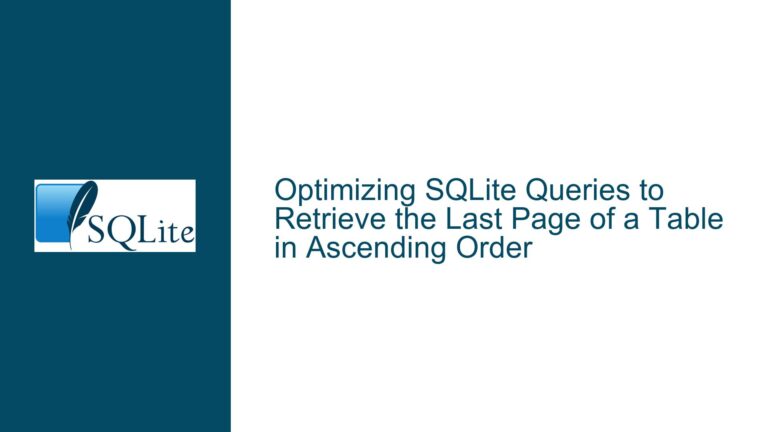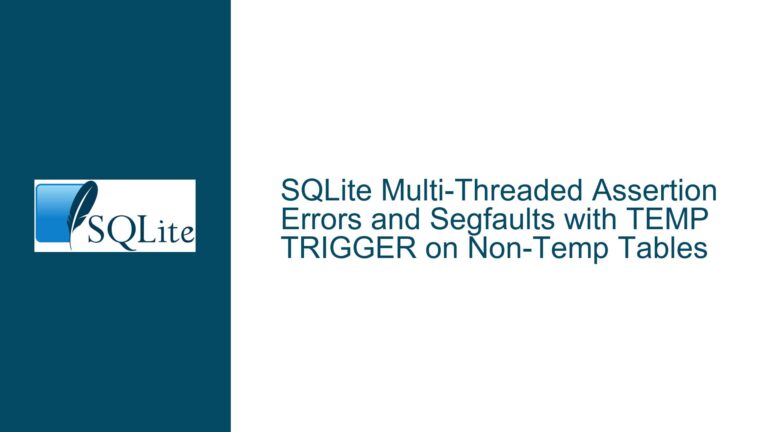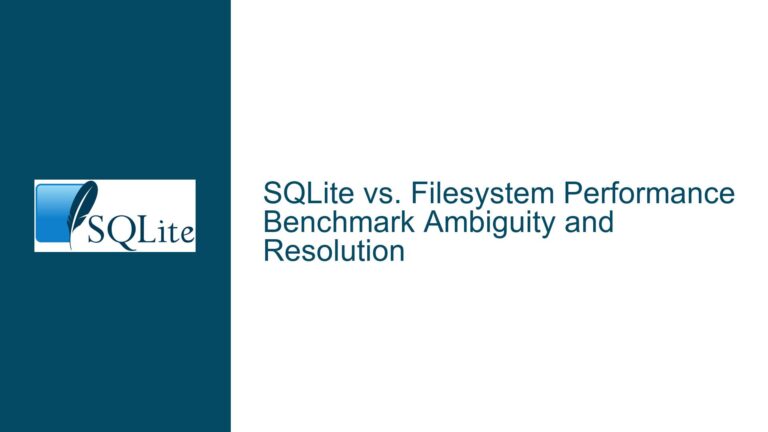Optimizing Virtual Table Joins to Prevent Repeated xFilter Calls in SQLite
Virtual Table Join Performance and xFilter Invocation Patterns
Issue Overview: Nested Loop Joins Triggering Excessive xFilter Calls on Virtual Tables
When working with SQLite virtual tables, developers often encounter performance bottlenecks when joining two or more virtual tables. A common manifestation of this issue is the repeated invocation of the xFilter method on one or both virtual tables involved in the join operation. This occurs because SQLite’s query planner defaults to using nested loop joins when no efficient index-based strategies are available, leading to quadratic time complexity proportional to the product of row counts in joined tables.
In the scenario described, a join between virtual tables O and C using c.id = o.c_id results in SQLite calling xFilter on the inner table (typically C) for every row processed from the outer table (O). Each xFilter call incurs significant overhead when the virtual table implementation interfaces with external data sources (APIs, file systems, or network resources), as these calls translate to repeated expensive I/O operations rather than in-memory scans.
The root expectation – that SQLite would materialize at least one table entirely before performing the join – conflicts with SQLite’s actual behavior. Virtual tables do not inherently cache their entire dataset in memory unless explicitly instructed through their xBestIndex implementation or query structure. The absence of indexing recommendations (via xBestIndex cost adjustments) and the lack of bulk data transfer mechanisms exacerbate this problem, forcing SQLite into a suboptimal execution plan.
Primary Catalysts: Query Planner Decisions and Virtual Table Configuration
Three interconnected factors contribute to this performance issue:
Nested Loop Join Algorithm Selection
SQLite’s query optimizer prioritizes nested loop joins when join constraints cannot leverage indexed access paths. For virtual tables returning identical cost estimates for constrained vs. unconstrained scans inxBestIndex, the optimizer assumes no benefit in materializing either table. It consequently iterates through the outer table and repeatedly scans the inner table viaxFilter, unaware of the high latency associated with each inner scan.Virtual Table Cost Miscommunication
ThexBestIndexmethod plays a pivotal role in guiding the query planner. When a virtual table’sxBestIndeximplementation returns the same estimated cost for full scans and constrained scans (e.g.,estimatedCost = 1e6for both scenarios), SQLite interprets this as equivalence in access efficiency. In reality, fetching the entire inner table once might be drastically cheaper than fetching individual rows multiple times. This miscommunication forces the planner into a nested loop strategy.Absence of Batch Data Transfer Mechanisms
Traditional virtual table implementations process rows one at a time throughxNextcalls. When joining large datasets, this results in O(N*M) complexity. SQLite 3.38.0+ introducedsqlite3_vtab_ininterfaces for bulk parameter handling inINexpressions, but equivalent mechanisms for joins remain absent. Without batched row retrieval or caching hints, virtual tables cannot amortize fixed overheads (e.g., API authentication, connection setup) across multiple rows.
Resolution Strategies: Cost Adjustments, Query Reformulation, and Caching
To mitigate excessive xFilter calls, employ a combination of query planner guidance, virtual table optimization, and strategic data materialization:
1. Recalibrating xBestIndex Cost Estimates
Modify the xBestIndex implementation to explicitly favor full table scans over constraint-based scans when batch data retrieval is more efficient:
Differentiate Cost Estimates: Assign a lower
estimatedCostto full scans than constrained scans. For example, if fetching the entireCtable costs 1000 units but fetching individual rows viac.id=?costs 2000 units per row, setestimatedCost = 1000for the full scan andestimatedCost = 2000 * estimatedRowCountfor constrained scans. This steers the planner toward materializingConce.Leverage SQLITE_INDEX_CONSTRAINT_EQ: In scenarios where the join key (
c.id) can be efficiently retrieved via external indexing, adjustxBestIndexto recognizec.id = ?constraints and return a lower cost for indexed lookups. This converts the nested loop into an indexed lookup join.
2. Query Restructuring for Materialization
Reformulate the query to explicitly materialize one or both tables using Common Table Expressions (CTEs) or subqueries:
Materialized CTEs:
WITH c_materialized AS MATERIALIZED (SELECT id FROM C), o_materialized AS MATERIALIZED (SELECT abc, c_id FROM O) SELECT o.abc FROM o_materialized o JOIN c_materialized c ON c.id = o.c_id;The
MATERIALIZEDhint forces SQLite to cache the CTE results in temporary storage. Verify this behavior usingEXPLAIN QUERY PLANto confirm fewerxFiltercalls.Subquery Flattening:
Replace the join with a subquery usingIN:SELECT abc FROM O WHERE c_id IN (SELECT id FROM C);This often prompts SQLite to scan
Conce, store the result set, and probe it repeatedly. Usesqlite3_vtab_inif the virtual table supports batchINlist processing.
3. Virtual Table Caching Layers
Implement a caching mechanism within the virtual table module to persist fetched data across xFilter calls:
Session-Level Caching:
Cache the entire dataset during the firstxFiltercall and serve subsequent requests from memory. UsexOpen/xCloseto manage cache lifetime per database connection.typedef struct VTabCache { sqlite3_vtab base; ExternalAPIData* api_data; CachedDataSet* cache; bool cache_valid; } VTabCache; static int xOpen(sqlite3_vtab *pVTab, sqlite3_vtab_cursor **ppCursor) { VTabCache* p = (VTabCache*)pVTab; if (!p->cache_valid) { p->cache = fetch_entire_dataset_from_api(p->api_data); p->cache_valid = true; } // Initialize cursor with cached data return SQLITE_OK; }LRU Caching for Large Datasets:
When materializing entire tables is infeasible, implement a Least Recently Used (LRU) cache that stores frequently accessed rows. Adjust cache size based on available memory and access patterns.
4. Leveraging sqlite3_vtab_in for Batch Processing
For SQLite 3.38.0 and newer, use the sqlite3_vtab_in interface to handle bulk IN constraints:
Bulk Parameter Binding:
ModifyxBestIndexto recognizeINconstraints and returnSQLITE_INDEX_CONSTRAINT_ISAfor bulk processing. InxFilter, usesqlite3_vtab_in_firstandsqlite3_vtab_in_nextto retrieve all values in theINlist at once.if (pInfo->aConstraintUsage[i].argvIndex > 0) { sqlite3_vtab_in(pInfo->aConstraintUsage[i].argvIndex - 1, "IN"); }Join Emulation via IN Lists:
Rewrite joins asINsubqueries where possible, enabling batch data retrieval. This requires application-level changes but can drastically reducexFilterinvocations.
5. Forcing Materialization with Temporary Tables
Create explicit temporary tables to hold virtual table data for the duration of the transaction:
- Explicit Materialization:
CREATE TEMP TABLE temp_c AS SELECT id FROM C; CREATE TEMP TABLE temp_o AS SELECT abc, c_id FROM O; SELECT abc FROM temp_o JOIN temp_c ON temp_c.id = temp_o.c_id;This approach bypasses virtual table performance issues entirely but requires schema modifications.
6. Query Planner Overrides
Use SQLite pragmas and optimizer hints to influence join order and materialization:
PRAGMA reverse_unordered_selects:
Reverse the default join order by settingPRAGMA reverse_unordered_selects=ON;, forcingOas the inner table.CROSS JOIN Enforcement:
UseCROSS JOINsyntax to fix the join order, though this may degrade performance if misapplied.
7. Custom Virtual Table Indexing
Enhance the virtual table module to simulate indexing through xBestIndex cost adjustments and constraint handling:
Pseudocolumn Indexing:
Introduce a pseudocolumn (e.g.,__rowid__) that maps to an external API’s native identifier. HandleWHERE __rowid__=?constraints inxFilterfor direct record access.Composite Constraint Handling:
Process multiple constraints inxFilterto simulate index intersections, reducing the number of rows retrieved from the external source.
By systematically applying these strategies, developers can align SQLite’s query execution behavior with the performance characteristics of their virtual table backends, eliminating unnecessary xFilter calls and achieving linear rather than quadratic time complexity for joins.






